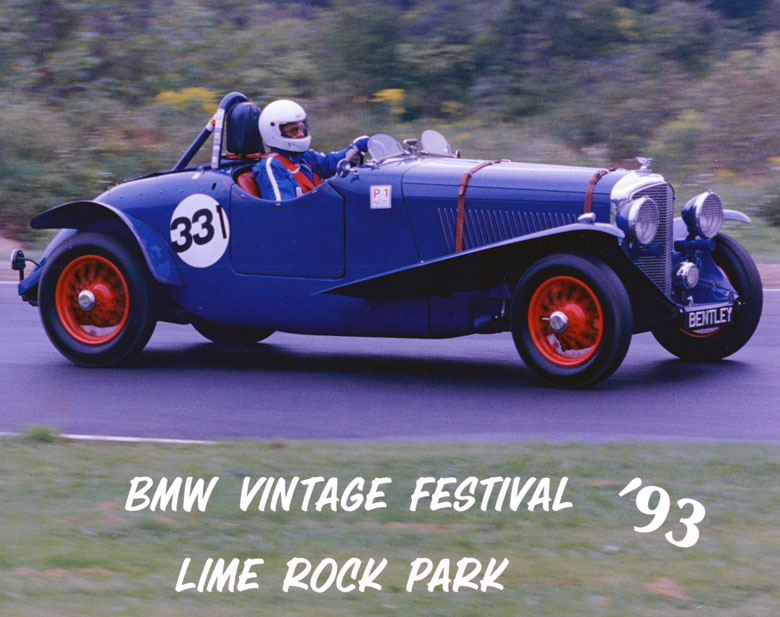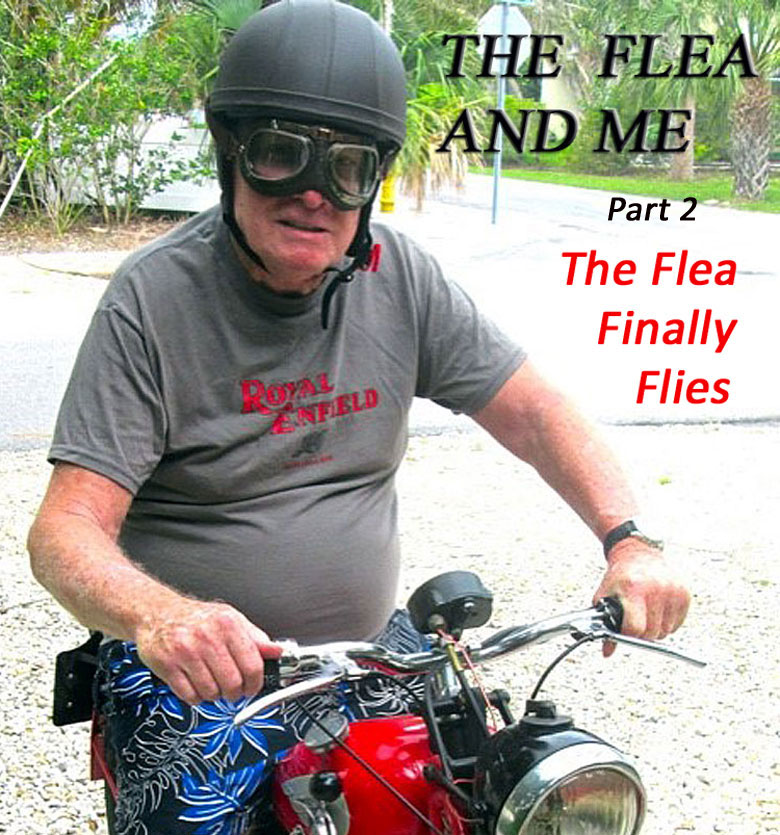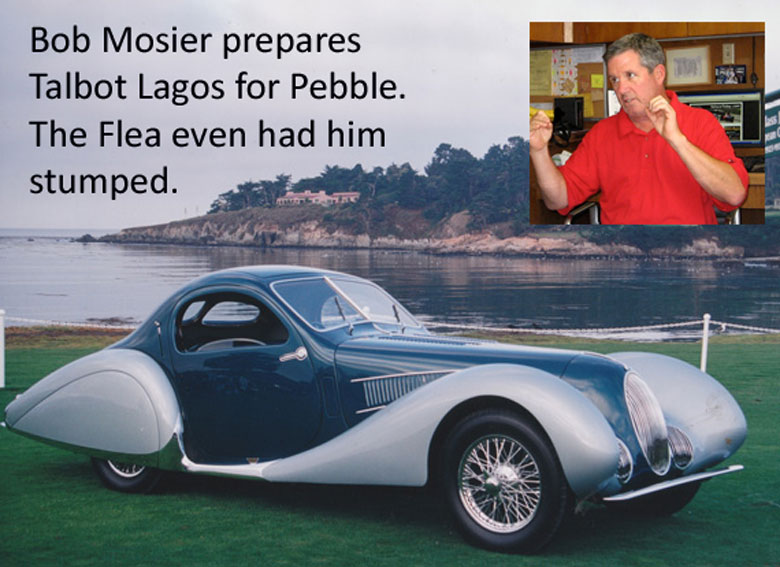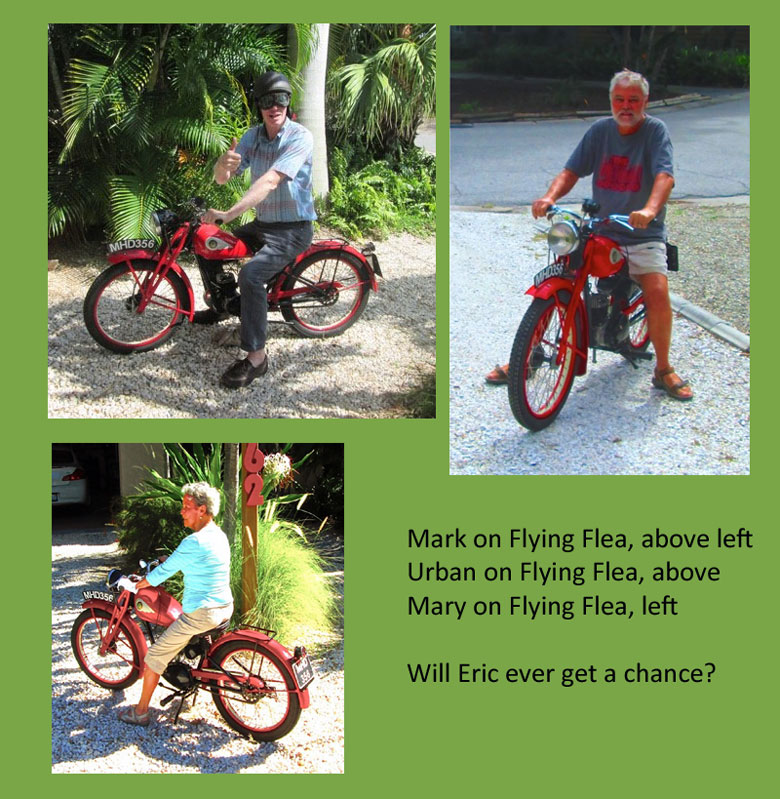It is June 5th, the day before D-Day, and we note the significant event by relating the story of the restoration of a Royal Enfield Flying Flea, a motorcycle designed to be parachuted out of an aircraft and used by British troops after the landing in France. In Part 1, Eric Davison recounted the joys of rebuilding the motorcycle his grandfather once wrote about. In Part 2, Davison has achieved the impossible; he’s gotten his Flying Flea running.
But will he ever be able to ride it?
Story by Eric Davison
The magneto came back from England and was installed. It generated spark but the bike would only cough.
About this time my brother and his wife came down for a visit. We tried to start the bike. Only coughs. We even tried bump starting it by pulling it behind my truck with brother Mark holding a rope. This was not only stupid but dangerous and ineffective.
My brother can make anything. When he returned to Michigan he created the ‘Flea Flicker’ a pair of rollers driven by a starter motor and powered by a car battery. Connected to a car battery, the rollers would drive the rear wheel and hopefully start the bike. A bump start. No dice.
Enter Urbie
About this time I met Urbie Green, who turned out to be a genuine find. A great friend. He and his wife, Sheila Foley, had recently moved to Sarasota. They had purchased a small house on a huge lot and was zoned so that he could erect a garage to store, work on, etc. the cars and bikes that he had kept when he closed his restoration business in New York.
The collection that he moved down included over a dozen bikes, A Velocette Venom was the star of a show that includes Nortons, BSAs and Triumphs. The cars are an MGC, and MGA, a Mini pick up truck, a Healey BN2 and a Maserati Mistral. All waiting to either be restored or sold.
After the no start episode, I called Urbie and he agreed to help me. Like anyone else who sees it, Urbie was seduced by the Flea and he jumped in with both feet. The engine finally got the attention that it needed. In removing the head and cylinder we discovered that the connecting rod was bent!
The task of removing the rod from the crank required special work and tools. Urbie didn’t have either. A local machine shop threw up its hands at the prospect of the job. Fortunately by this time another year had rolled around and my brother was back for the annual visit. He determined that the best course of action was to send the crank to him.
So I did, this time getting a tracking code number.
Unfortunately, Urban Green passed away as the result of a stroke last February.
After a couple of weeks of soaking and the use of a press, the crankshaft came apart. Mark then contacted Hitchcocks and ordered a new rod and piston. Hitchcocks has an on-line parts catalog for almost all Enfields. When the new piston arrived as ordered for a 125 cc motor, it was different than the piston that was in the motor. More back and forth with Hitchcocks led to the conclusion that the piston that was in the motor was from a 150cc motor. The rod was the same as was the distance from the center of the wrist pin to the top of the piston. There should not have been a problem of any kind.
Except that the piston now hit the head. Impossible, no dimension had changed but facts is facts. Urbie and I measured the distance and specs went back to Mark who made a shim to be placed between the crankcase and the cylinder barrel. Who knows what disasters had been suffered by my Flea.
All should now be well. Well, sorta. Still intermittent spark. We replaced the condenser. No change. Plug. Same result.
Thinking that the points may be the problem and since they could not be replaced, I sent them back to England, to D.H. Day who had rebuilt the magneto. All was fine except that shipping them to England was $95. Better to fly this stuff over and put it in your luggage.
By now I was going crazy. I needed advice. The best person to call was Bob Mosier. Bob is a friend from California who just happens to run one of the top auto restoration shops in America. His work has taken many medals at Pebble Beach. (Read Eric’s story on Mosier Restorations.)
He recommended that I contact Bob Smith, better known as the Magneto Doctor. I did so and off the mag went to Smith in Nevada where he looked it over and decided to rewind the coils and sent it back.
This time there was spark and the little bugger ran. It even took me for a ride around the block. Then it stopped and refused to refire. By now I had stumped all the experts and had no idea where to turn.
By chance I was thumbing through Hemmings and came across a small ad placed by Ed Strain in nearby Pinellas Park, about 25 miles away. Mr. Strain services brake systems and magnetos (but not of the flywheel type.)
I called him and he agreed to give me 30 minutes if I could get to his place by 7 am the coming Saturday. I loaded up and off I went. I knew I was in the right place when I saw the sign on his door. “Welcome to Old Technology.” Inside was every conceivable piece of machinery; lathes, mills, drill presses. Along with his daughter he did it all using mostly word of mouth for advertising.
Mr. Strain was a delight and his 30 minutes turned into two hours. All systems checked out and but he did replace the condenser with the advanced type, a solid state piece.
He also was charmed by the Flea and would take no payment.
In loading and unloading the Flea from my truck I inadvertently chipped the rear edge of the front fender. Urbie took one look at that and was incensed that the fender had been finished using bondo.
So, the fender came off and went to be sandblasted. With that done Urbie took it under his wing to tap out all the dents and to properly prime and repaint it. Now it is correctly done.
How to title a flea
I had purchased the bike with a bill of sale. I did not realize that bills of sale are not accepted in Florida as I discovered when I went to the DMV with it in hand. I was told there that I needed to get a Declaratory Judgement and to do so I would need to hire an attorney to present my case to a judge. Bah, humbug.
Fortunately Anna Maria is patrolled by the Manatee County Sheriff’s department and in conversation with one of the deputies I told him of my problem. His advice was that I should apply for a title based on the fact that the bike was a salvaged piece and assembled from parts. I then prepared a written document to that effect.
With that in hand off I went to the County clerk’s office in downtown Bradenton. Yes, I did need to get a Declaratory Judgement but I could plead my own case to the judge. However, it did cost $300 to get on the docket. After paying that I was sent to the Motor Vehicle Inspection department in nearby Palmetto where after filling out some forms and paying $30 I was told to wait for notification of the hearing date before the judge.
The date arrived and Mary and I headed to the court house. I had prepared a written dossier and included photos so the judge didn’t have to waste time questioning me. I think he was amused to have an 80-year-old applicant for a Declaratory Judgement for a motorcycle appear in front of him. Two gray haired people looking to register a 66-year -old motorcycle!
He was more than helpful and while we were in court he called the Inspection department and instructed them to go to my house and inspect the bike so I didn’t have to haul it to Palmetto and the inspection station. Age does help sometimes.
Within a week the inspector showed up. He was a Triumph guy and loved the Flea and signed off, sending the proper forms and releases to the County Clerk. After a week I called the County Clerk and asked what I should do next. After being bounced around to various departments none of whom had any answers I wrote a note to Judge Singer.
That worked. The Clerk called and told me to come back to the court house and pick up the signed and approved documents that I could now take back to the DMV. Victory was near at hand.
I appeared at the DMV and after paying another $150 I received all the stuff including a ‘Vintage’ license plate. I won!
I had been earlier informed by wife Mary that my riding the bike was an iffy proposition. I had never owned a motorcycle before and I don’t heal as fast as I used to.
First consideration was that I MUST wear a helmet. To that end, the year I bought the Flea my eldest son decided that Dad must have a proper English helmet. He located a leather flying helmet, split lens goggles and a white silk scarf. I was given this package for Christmas the year I bought the bike. The idea was to get a photo of me in proper English regalia. I thought son Bruce was going to split with laughter when I unwrapped the package.
Then realizing that the soft flying helmet would do no good in a tumble I invested in what the Brits call a pudding bowl helmet. Round. I am ready!
Or so I hoped. I was still not getting a spark. There would be one and then there would not.

Dale Powers is another accomplished automotive expert. Here he is at Lime Rock in 1993 with his Bentley Sports.
By this time I had become friends with Dale Powers. Dale is retired. His business had been twofold. He had been the owner of a very successful high-end automotive restoration and repair shop in St. Petersburg, Florida. His specialty had been Rolls Royce and Bentley cars. He also traded in vintage models of those marques. As partial retirement loomed he had become the official North American distributor for vintage Rolls and Bentley parts, a business he ran from a building on Pine Avenue, the main street of the City of Anna Maria (pop. 1700). (Read Eric’s story on the Fascinating Finds of Dale Powers.)
Dale’s knowledge of all things automotive is encyclopedic but my Flea problem stumped him. But, he had a close friend who had been his protege at the shop in St. Petersburg and who now built sports racing cars powered by two-cycle engines.
So, of we went (Dale and me) to Mike Moensch’s shop and hopefully some serious two-cycle attention. The issue was that there was sometimes spark and sometimes not. Why? Serious head scratching and a disassembly of the motor revealed that the woodruff key that held the flywheel in position had worked enough so that every time the engine was kick started the timing was affected. The slots in both the flywheel and on the crank had become distorted.
Mike’s resources included a man who would weld the slots solid and then machine new grooves for the woodruff key. Needless to say there was considerable delay in the process. As the proprietor of a large and successful business making the Flea run was more of an exercise in problem solving and was not front and center: it was a favor for a friend of his friend Dale. But, finally the day arrived and by chance it was a day when my brother and his wife had come from Michigan for a visit.
So, brother Mark, Dale and I loaded into my truck and drove to St. Pete for the unveiling. There it was in all its glory; running and with the sweet smell of Castrol pouring out the exhaust. The fates made sure that my brother was present and that delivery date was Friday, April 13, 2018. Only 12 years in gestation. What the heck, it took 17 years, of research, gathering and funding to put my MG J2 on the road. I am improving.
Now it is home, completed and in the garage. It has a vintage license plate and all that is needed is a rider with a bit more courage than I possess.
Whether or not I ride it is up for discussion. Eighty-three is not the time for me to take up such a loony activity. Tearing around our little island for a time appeals to me.
Then maybe put in on display in the living room? The lady Mary will decide that. Either I ride it or into the living room it goes. We shall see!
If you are a subscriber, you can read about Eric Davsion’s memoirs of the Street Years at Watkins Glen on pdf:
To access his Glen Memoirs, click here and then and click on each icon for the Pdf.



What a great story, being English and a lover of old British bikes, I loved every minute , peter
Yes, what a great story well told and intriging.
Congratulations!
Eric, a great article for sure. Dale is my RR/B parts mentor and Mike Moench is my go to RR/B repair shop. I hope that you have better luck than I bringing such treasures into the house. Regards, Hank Feinberg